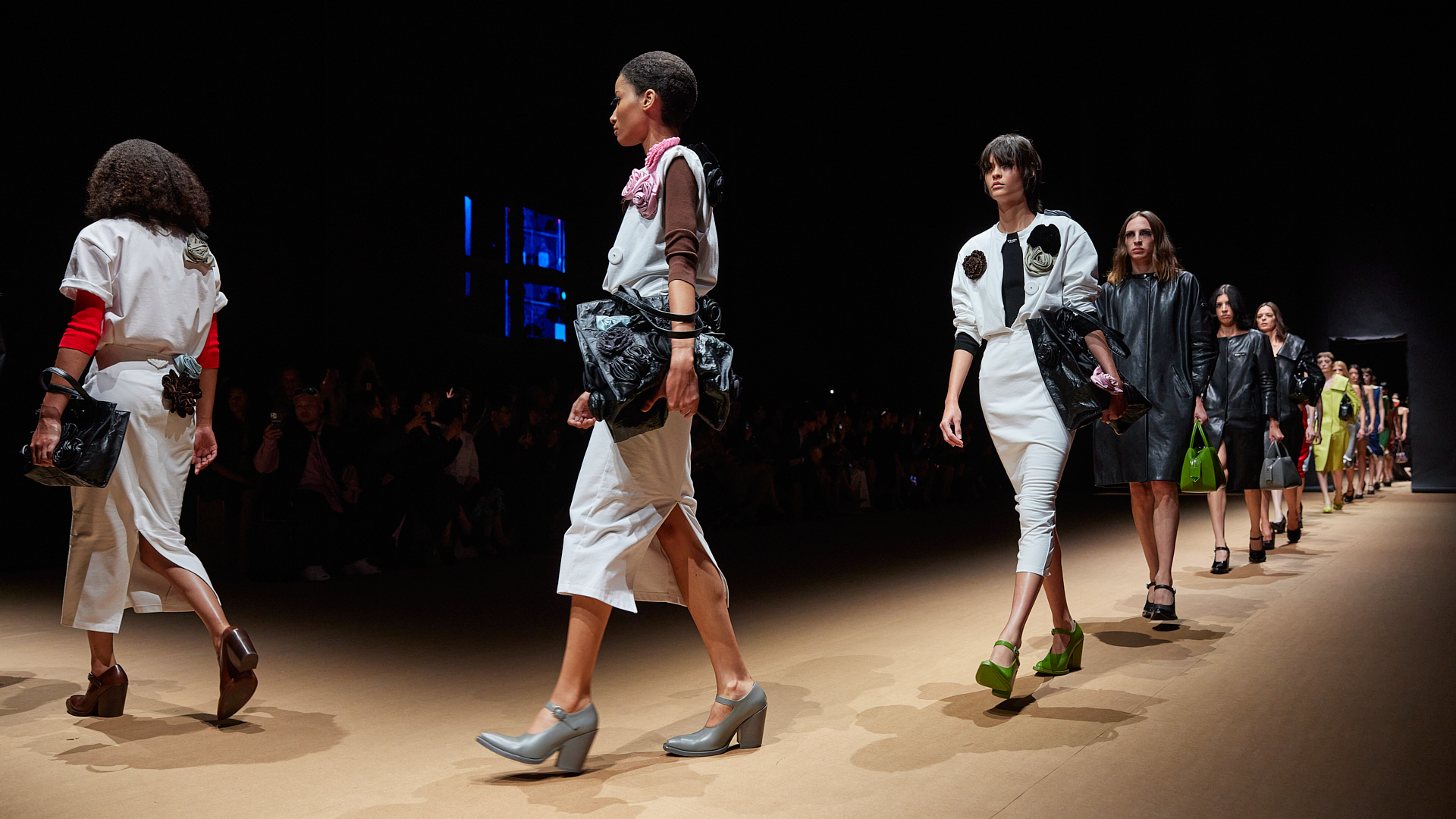
After a subdued London Fashion Week S/S 2023 in the wake of the death of Queen Elizabeth II, eyes turned to Milan, where a packed schedule was perhaps the city’s busiest yet. Spanning creative director debuts (Ferragamo, Etro and Bally all welcomed new designers this season), anniversary celebrations (Moncler’s 70 years), and collections from both the city’s stalwarts and an energised emerging generation of designers, Milan Fashion Week S/S 2023 represented a return to form after several seasons of uncertainty since the outbreak of Covid-19 in 2020.
‘Interest in the Milano Fashion Week is growing all the time, and this is reflected in the variety of the projects that we are about to stage,’ said Carlo Capasa, president of the Camera Nazionale della Moda Italiana (CNMI), ahead of the event. ‘We are aware of the uncertainties that the global social and economic scene presents, and it is in these very times that fashion is summoned to give a message of confidence and positivity.’
Here, Wallpaper* reports on the highlights of Milan Fashion Week S/S 2023.
The best of Milan Fashion Week S/S 2023
Sunday 25 September
Giorgio Armani
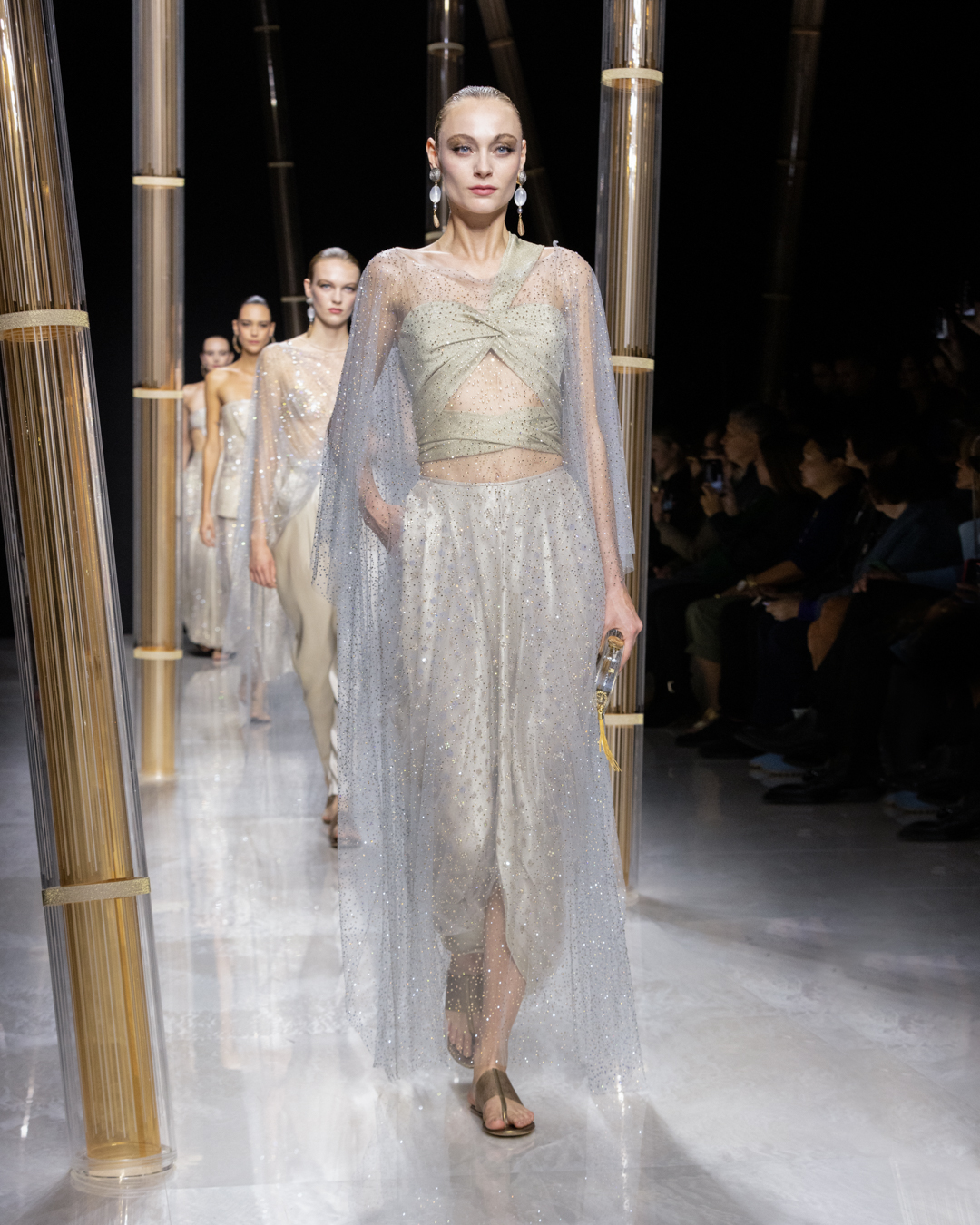
‘The essence is a certain purity and the glimmer of gold,’ came the introduction to Giorgio Armani’s S/S 2023 collection, titled ‘Fil D’or’ – golden thread – which showed the designer’s continuing mastery of embellishment and lightness of form (the latter has been an ongoing theme in recent collections, including at Emporio Armani earlier in the week). The precious metal was evoked not only in gilded elements – smooth metallic handbags, coils of chain necklaces, a surfeit of delicate golden paillettes – but also in the otherworldly sheen of the seemingly weightless fabrics utilised in the collection’s diaphanous silhouettes (‘long, liquid and evanescent like a desert mirage’). It ended with a shimmering flurry of evening wear, for which the designer is renowned – no doubt appealing to a typically star-studded front row, including actress Cate Blanchett, who presented Mr Armani with the Visionary Award at Camera della Moda Italiana’s Sustainable Fashion awards later that evening (in glittering Giorgio Armani sequins of her own).
Ferrari

The historic Teatro Lirico provided the backdrop for Rocco Iannone’s third outing at Ferrari, the Italian designer continuing to evolve and define the automotive heavyweight’s still-young fashion label. While previous seasons have seen Iannone stick closely to script with designs linked to the Ferrari’s racing heritage – belts like car seatbelts, fabrications inspired by car interiors, versions of pitstop overalls – this season he looked towards what he called the ‘human element in the legendary history… the visions, ambitions and emotions that revolve around the Prancing Horse’. As such, Iannone had collected photographs of various movie stars and musicians alongside Ferrari cars, using them as the nexus of a fluid, Californian-inflected collection which melded silk Hawaiian shirts, colourful bleached denim and shimmering moments of embellishment with the racing-inspired silhouettes previously the bedrock of the label (overalls, body-conscious Ferrari-emblazoned sweaters, caps and hoodies continued to feature). The presentation was accompanied by a short film, The Dream of Dreamers by Italian-Canadian director Floria Sigismondi, ‘encapsulating feelings of self-expression, of passion and freedom, of a constant drive towards that which is extraordinary and incredible’.
Saturday 24 September
Moncler

Looking down from a terrace high above Milan’s Piazza del Duomo, an endless sea of bodies clad in white looks by Moncler gathered beneath for a dramatic celebration of 70 years in business for the Italian label (the event heralded the start of 70 more days of anniversary events). The 1,952 participants, from models to musicians – the number marking the year Moncler was founded – each wore a version of the Maya jacket, a nylon down-filled puffer which is perhaps the label’s most recognisable garment. Streaming into Milan’s most famous square, they moved in unison in an open-to-the-public performance choreographed by Sadeck Berrabah – ‘a unique reinterpretation of contemporary dance, stretching the geometric limits of the human body’. Despite the heavy rainfall, an estimated 18,000 people witnessed the event. ‘What I am most proud of is that we gathered together all generations, and felt the strong energy coming from our communities,’ said Remo Ruffini, Moncler’s CEO. ‘It is with them that we want to build our next 70 years. At Moncler we dream together, not alone.’
Bottega Veneta
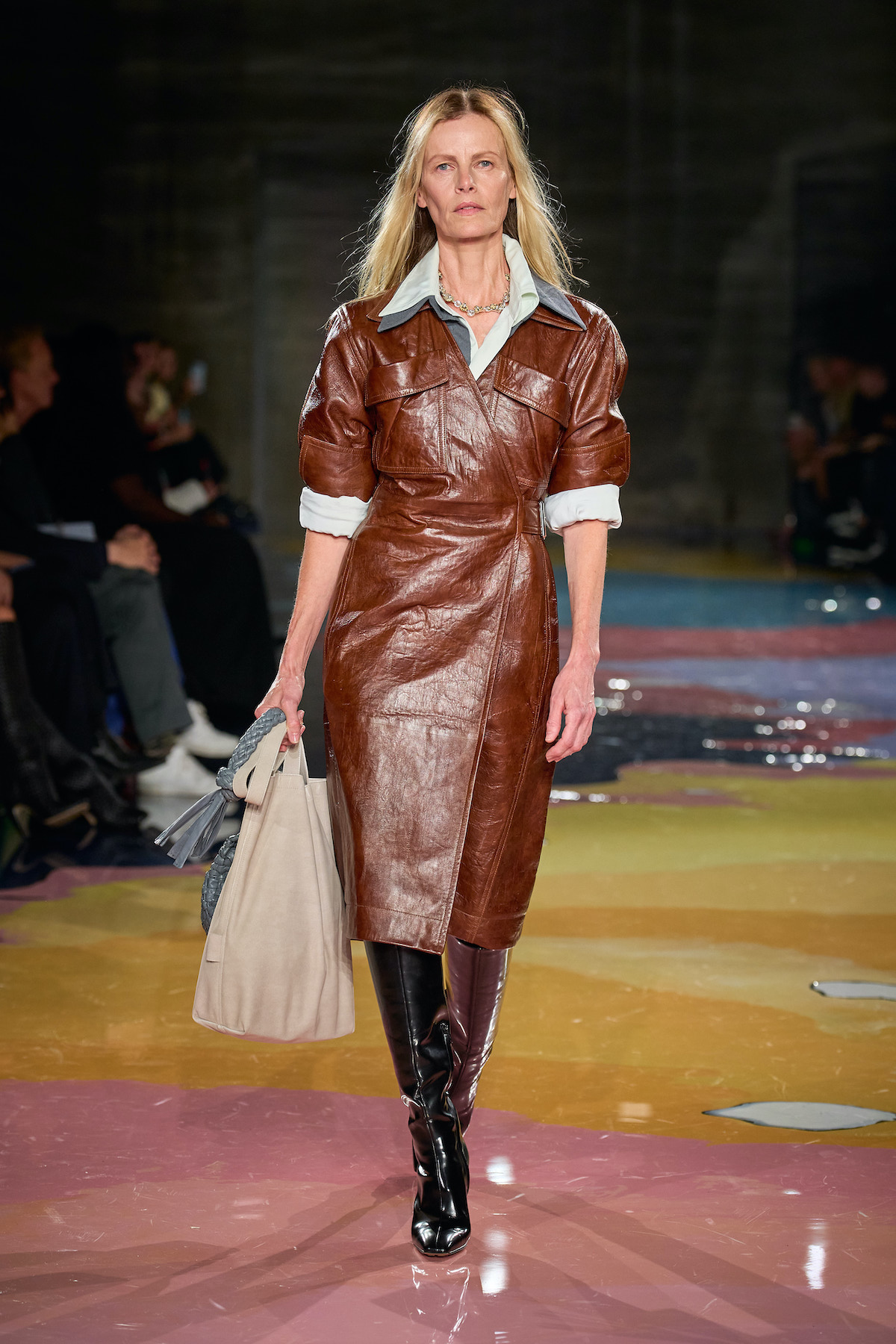
Matthieu Blazy said that his sophomore collection for Bottega Veneta began with a conversation with Gaetano Pesce, the 82-year-old designer-artist-architect who created the show’s set – a series of 400 unique chairs and poured-resin floor in his colourful style. Blazy noted that they spoke about the idea of creating ‘the world in a small room’, the broad multiplicity of human life momentarily captured on a Milanese runway. ‘We are all originals, and this is one of the themes of my design,’ said Pesce, whose own work is defined by a resistance to repetition. ‘As a designer I make originals, not standardised series, that’s the old way – this is the new way.’
Receive our daily digest of inspiration, escapism and design stories from around the world direct to your inbox.
This line of thinking permeated Blazy’s collection, the Belgian designer noting a desire to move between the ‘archetypal and the individual’. ‘I wanted to design not just for one woman or one man, but for women and men,’ he said, instead conjuring an eclectic cast of individual characters which streamed out at speed (Blazy also noted he wanted the presentation to have a feeling of ‘movement, agency, sensuality and life’; the result was something akin to looking out at a busy city street from the seat of a café). It made for an expansive offering – there was something generous about the collection’s breadth – spanning plaid shirts and denim jeans, bourgeois tailoring and overcoats, crystal and tassel embellished dresses, and of course an array of highly covetable accessories.
But Blazy also noted a ‘discreet perversion’ which lingers beyond the collection’s surface – that flannel shirt might actually be crafted from nubuck leather, a fur coat from mock fox, printed on goat leather. It speaks something of his understanding of the strange, near-fetishistic desire one can have for an item of clothing – here heightened by extraordinary and unexpected feats of craft. For Blazy, it is the relationship between maker and wearer which is at the heart of his vision for Bottega Veneta, ‘an emotional investment in objects for life – in both senses of the term’.
Dolce & Gabbana
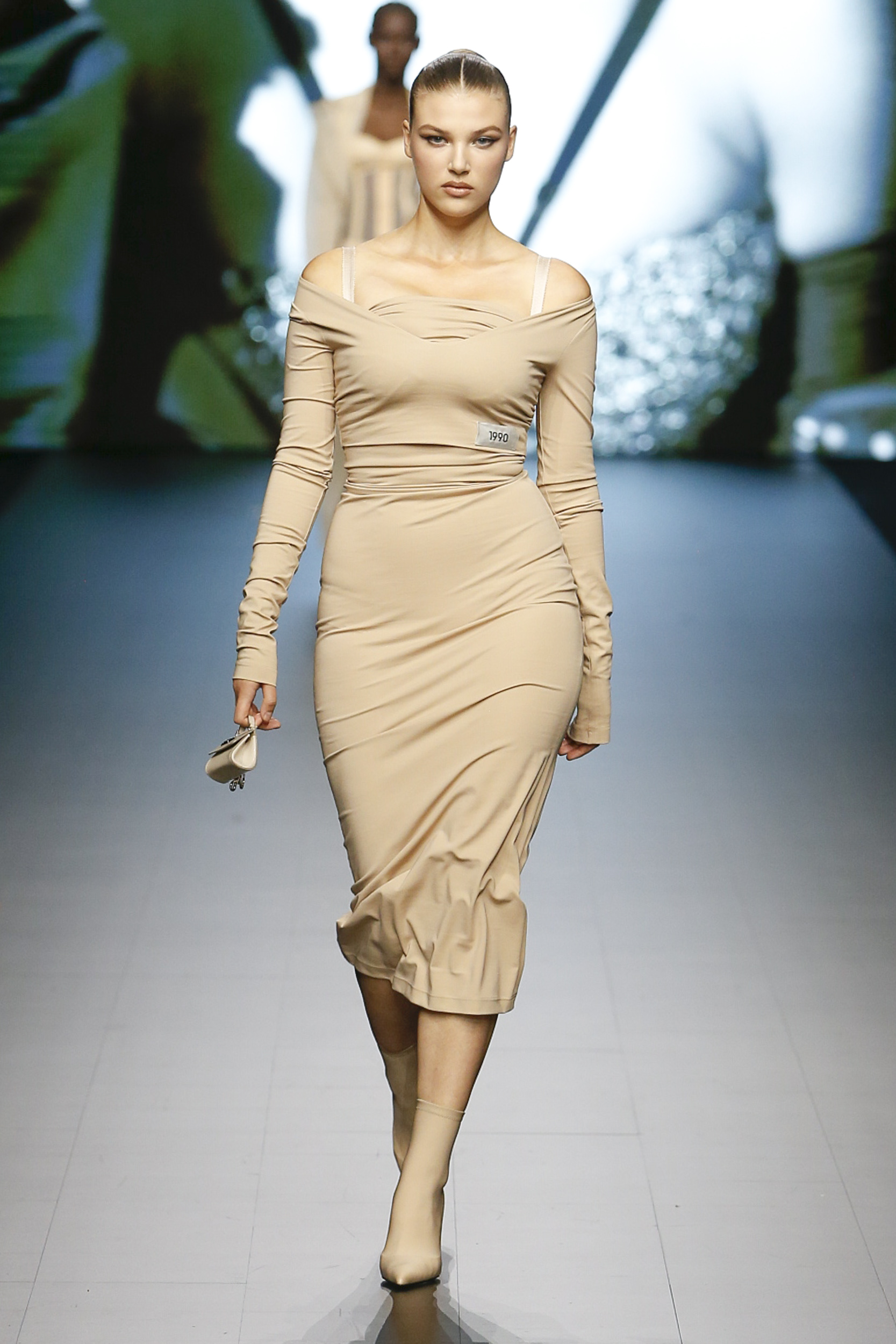
The reality star and entrepreneur Kim Kardashian has been collecting Dolce & Gabbana since growing up as a teenager in Los Angeles in the 1900s and early 2000s, eras that informed ‘Ciao, Kim’, the house’s S/S 2023 womenswear collection shown in Milan on Saturday (such a fan was Kardashian, she had two dogs named ‘Dolce’ and Gabbana’). A collaboration of sorts, Kardashian ‘curated’ a series of her own favourite archival pieces to be ‘rethought, repurposed, reinterpreted’ by Stefano Gabbana and Domenico Dolce (much like the pair’s S/S 2023 menswear show this past June). Backdropped by a slow motion film of a blonde Kardashian eating pasta in slow motion and dressed in the house’s bombshell style, the various looks played on Dolce & Gabbana’s body-conscious signatures featuring elements of corsetry, ruching, and lingerie. Stefano and Domenico said by looking back to their design history they hoped to reach different generations – ‘everyone will see in it something different in which to recognise themselves’. Judging by the screaming crowds of teenagers outside, they’re right.
Ferragamo
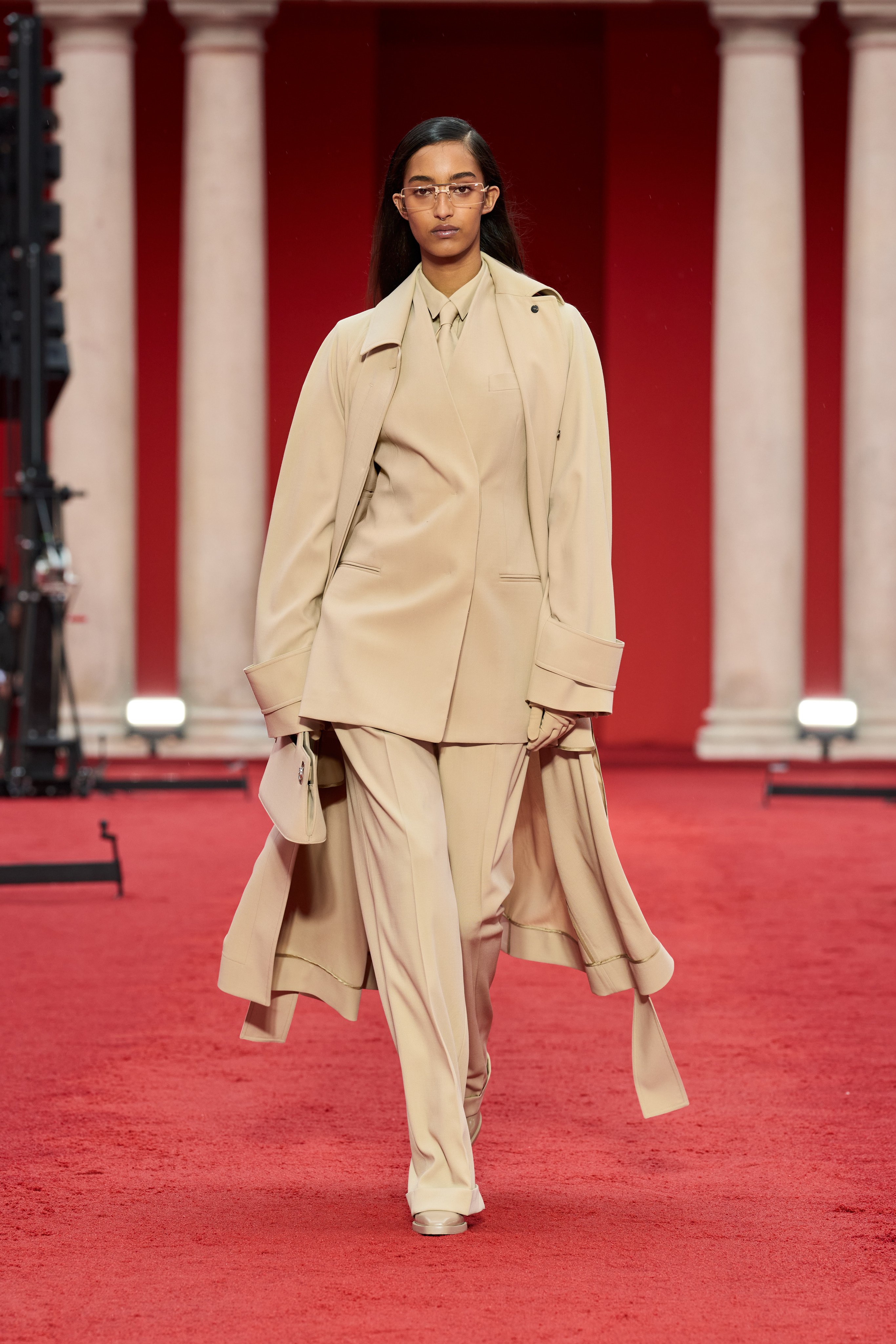
Expectations were high for 27-year-old British designer Maximilian Davis’ first collection for Florentine house Ferragamo, which was prefaced earlier in the week with a redesigned logo by legendary graphic designer Peter Saville – black on a red backdrop, colours Davis has been drawn to in his short career so far – and the drop of ‘Salvatore’ from the name. Any doubts that the young designer would not be up to the task were quickly dispelled with an sleek, elevated offering which tended towards minimalism and drew a distinct link between the past and present of the house – notably, in his evocation of Hollywood, where the house’s eponymous shoemaker began his own career in the 1920s.
‘I wanted to pay tribute to Salvatore’s start by bringing in the culture of Hollywood – but new Hollywood. Its ease and sensuality; its sunset and sunrise,’ the designer said of the collection, which drew inspiration from artist Rachel Harrison’s ‘Sunset Series’. Spanning both mens and womenswear, this encompassed layers of elegant tailoring – the opening looks were entirely in beige, from trench to blazer to shirt and tie – while a series of glimmering red looks paid ode to a pair of red crystal shoes the house founder created for Marilyn Monroe. Semi-sheer dresses hung off the shoulder, inspired by what the designer called ‘the purity of Florentine drape’, while notes of the subversion channelled at his eponymous label arrived in sliced away leather mini shorts (for men and women), low-slung waistlines, and silhouettes sliced to the navel.
As for accessories – Ferragamo is an accessories house at heart, after all – Davis proved particularly adept at what was for him a new discipline. A series of almost-flat handbags proved a particular highlight, crafted from smooth sculpted leather, as were cut-out leather and suede tote bags. A more classic holdall was inspired by the house’s existing Wanda bag, first created in 1988. As for shoes, a circular heel, in reference to the house’s Gancini motif, provided a moment of play. ‘It was about looking into the archive and establishing what could be redefined to become relevant for today,’ said Davis of this opening gambit, a clear-headed start from a designer who already looks settled in.
Jil Sander
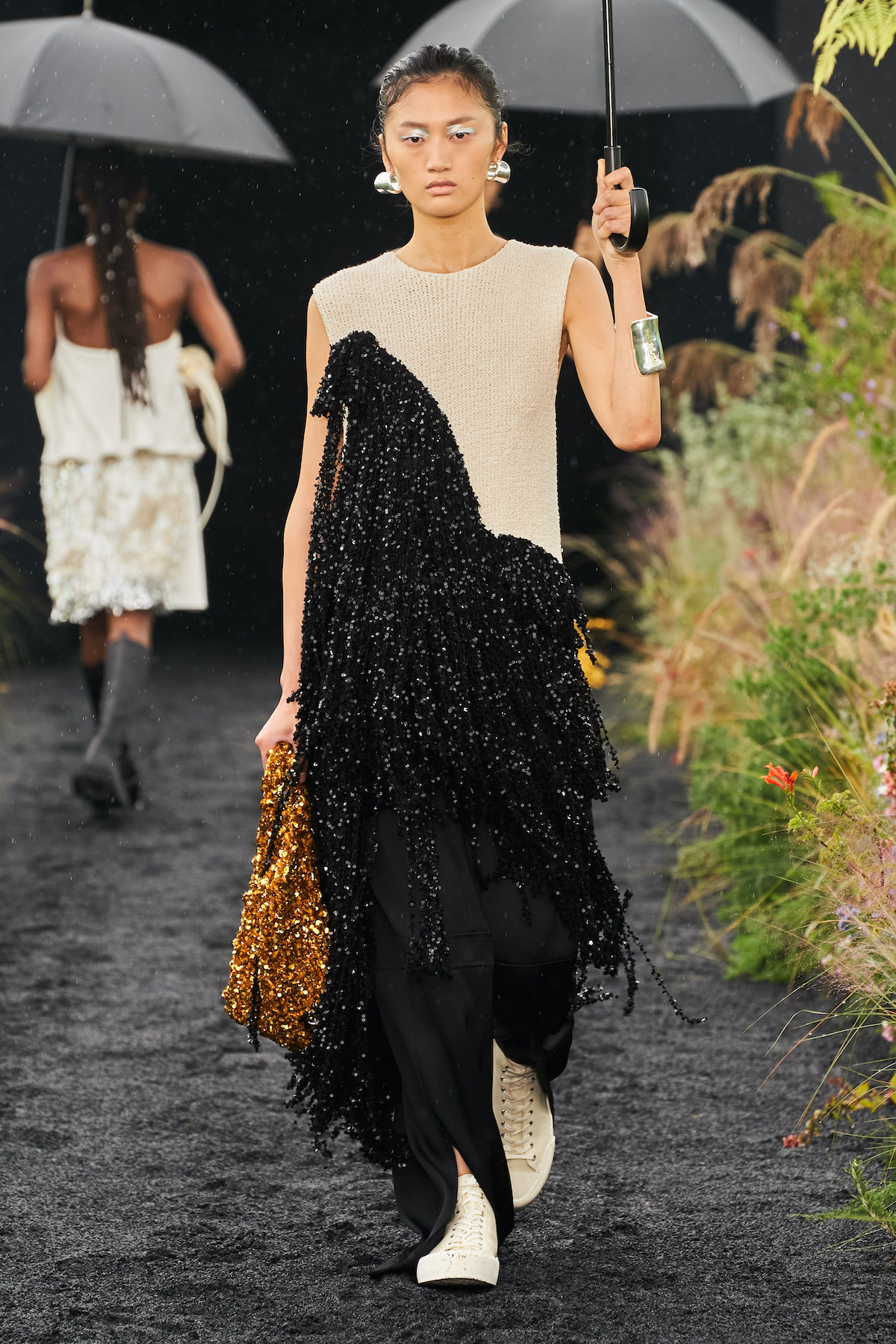
Despite the drizzle, Lucie and Luke Meier went ahead with their al fresco runway presentation, its backdrop a verdant garden housed in an open-to-the-elements grey box at the edge of Milan (albeit with the necessary addition of black umbrellas which accompanied each of the model’s looks). A cross-gender offering, the Meiers called it a collection of ‘ease, lightness, smooth lines, elongated silhouettes’ which had a heavy focus on tailoring, with numerous plays on oversized suiting (a blazer might have its sleeve removed, trousers replaced by a kilt). But it was best when the designers let loose towards the end of the collection – unruly glimmering tassels emerged from beneath a clean-lined tabard, mirrored bubbles were stitched onto an otherwise precise black top. Part of a collection which paid homage to the ‘new and different world’ of America’s West Coast, these looks were their take on Hollywood dress – a striking fusion of ‘sartorial glamour, romanticism and realism’.
Ports 1961
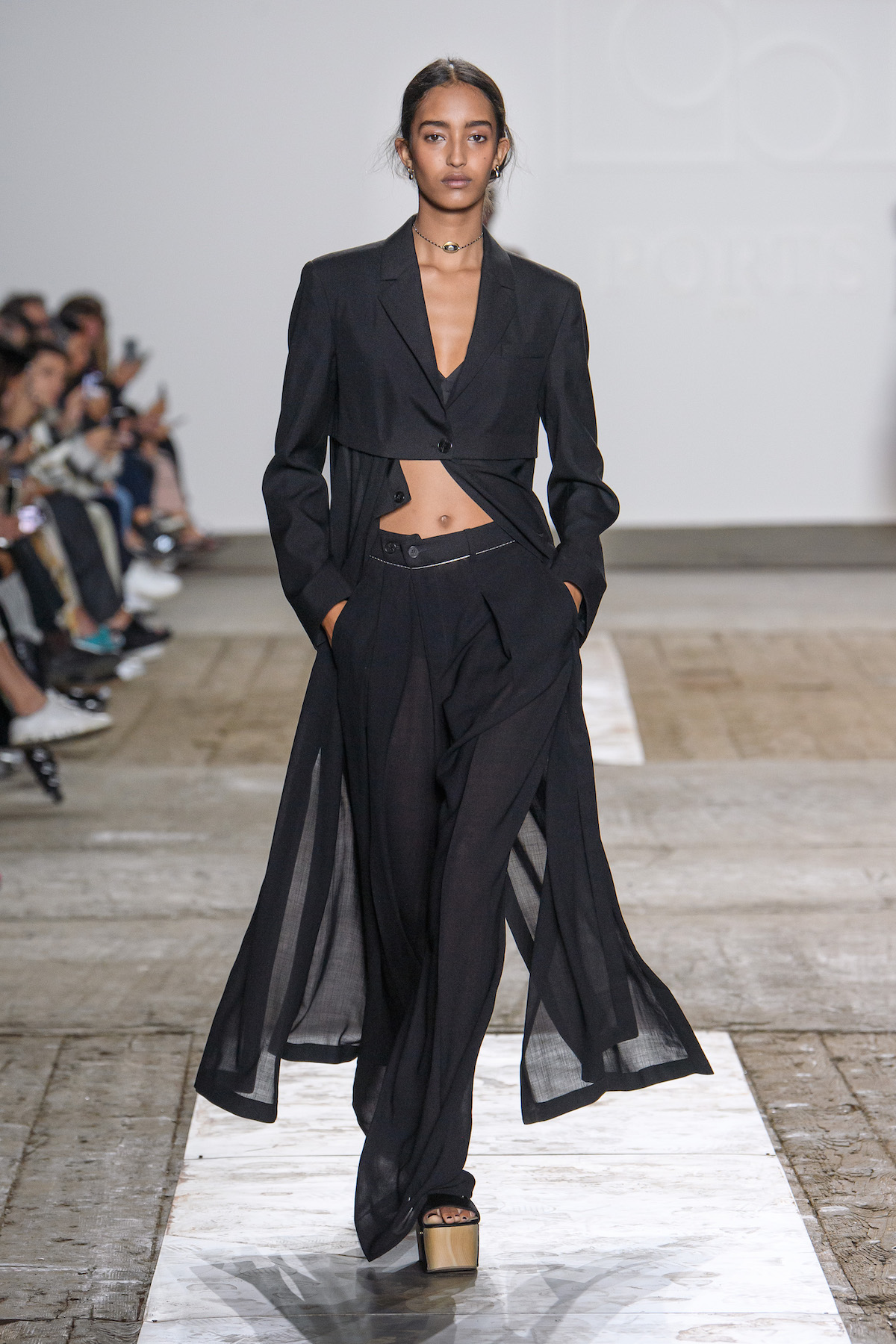
There was something refreshing in the lack of ceremony around Karl Templer’s latest collection for Ports 1961, which was presented in a warehouse on Milan’s outskirts, wooden floors left bare and a simple white backdrop erected at the end of an intimate runway. Templer said he was ‘experimenting with classics’ this season, taking the stalwarts of a woman’s wardrobe and ‘slicing, peeling, layering them to add movement, elongation, fluidity’. It began with a beautifully proportioned black suit – its elegant wide-leg trousers pooling at the ankle – before taking this feeling of fluidity into simple silk tunic dresses, two-tone trench coats, and semi-sheer shirt dresses adorned with checks. Moments of subtle subversion exemplified what Templer called ‘broken classicism’: aran knits fell away into tasselled braids, tailoring was sliced to reveal the lining beneath, while undone slithers of chiffon drifted in the breeze like streamers.
Friday 23 September
Versace
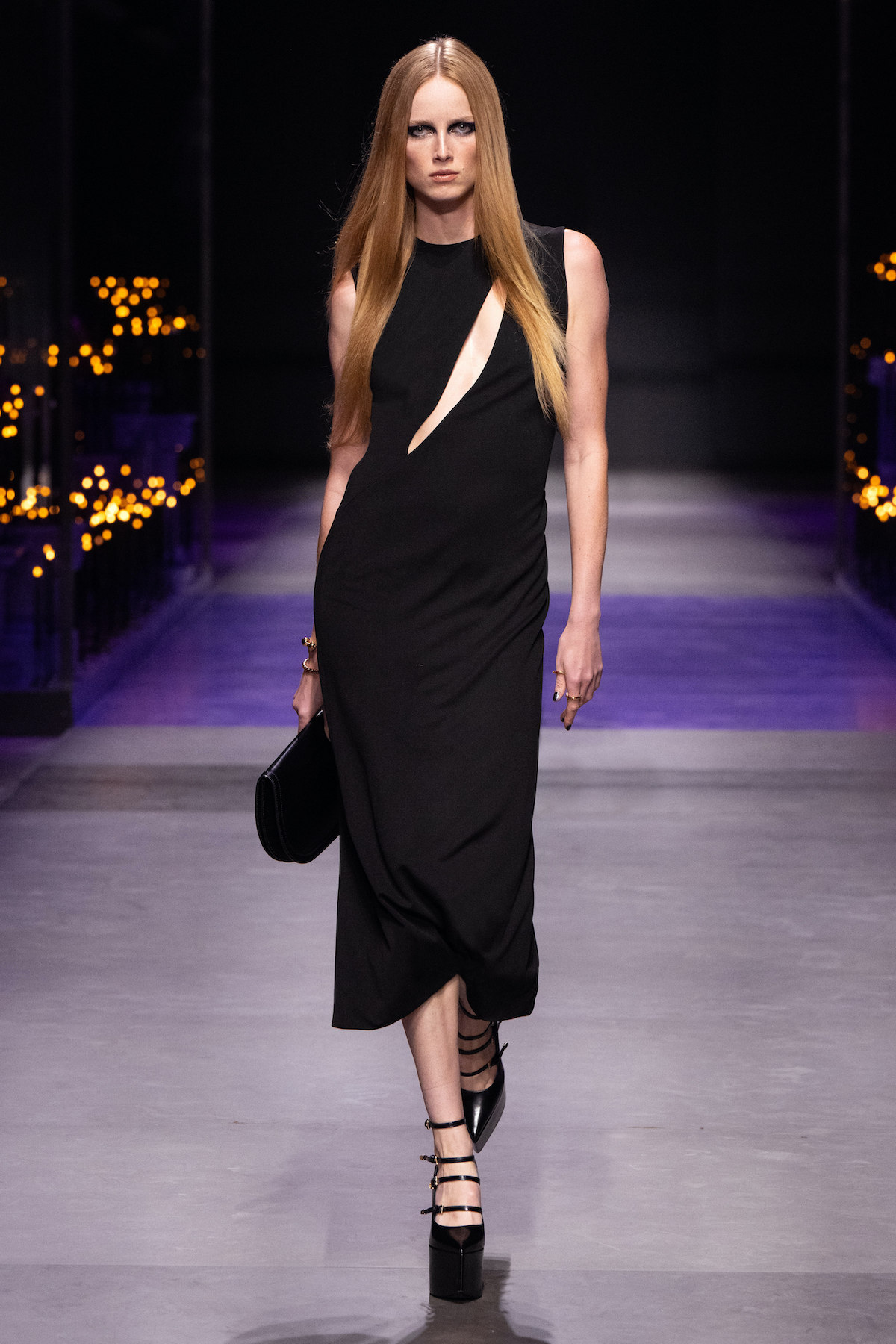
A typically high-octane outing by Donatella Versace ended with a runway appearance from Paris Hilton, who closed the show in a chainmail mini dress and veil (naturally, in the star’s signature Barbie pink). Held in a space bathed in purple light in which various glass ‘rooms’ were filled with black candles, gothic stained-glass windows and Versace furniture, Donatella said that her woman for the season was a ‘dark, gothic goddess’. Indeed, the opening four models – posing briefly in a dramatic milieu among the lit candles – were clad entirely in black, dresses slashed and towering platforms on their feet, while crumpled silk, lace and leather met 90s-inspired silhouettes (micro minis, babydoll slips, halter tops, fitted motorcycle jackets). ‘I have always loved a rebel. A woman who is confident, smart and a little bit of a diva,’ Donatella said of the season’s muse. ‘She wears leather, studs and frayed denim and she has enough attitude to mix them with chiffon, jersey, and a tiara. She is a strong liberated woman; she is gorgeous; she knows it. She is the goddess of freedom.
Gucci
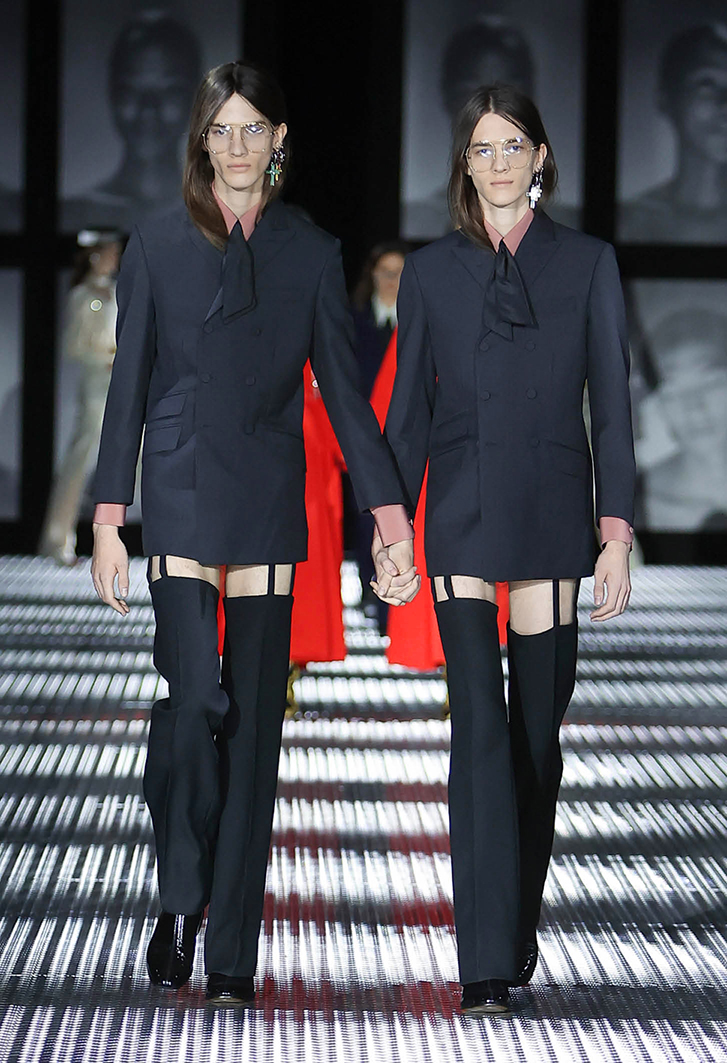
Halfway through Gucci’s latest collection a vast central wall rose up to reveal that two identical fashion shows had been taking place at the same time. Identical down to the models, who were each a pair of twins, a spectacle of breathtaking proportion – in total there were 68 sets of twins who walked the show – which paid ode to designer Alessandro Michele’s mother, who was a twin herself. ‘I am a son of two mothers: mum Eralda and mum Giuliana. They were magically mirrored. One multiplied the other. That was my world, perfectly double and doubled,’ he wrote in a letter which accompanied the show.
But the gesture was also an exploration of reproduction and repetition; Michele noted he was fascinated by the idea that even two identical garments, on two identical bodies, can still appear different in often inexplicable ways. ‘The effect is alienating and ambiguous. Almost a rift in the idea of identity,’ he wrote. ‘And then, the revelation: the same clothes emanate different qualities on seemingly identical bodies.’ Or, as Marianne Faithfull intoned as part of the collection’s soaring soundtrack: ‘alike, but not alike’.
The collection itself once again showed Michele’s ability to bring disparate elements into unexpected unity – from Gremlins, printed on dresses or stuffed into handbags (the 1980s movie monsters are themselves able to duplicate identically) to suspender trousers and shimmering sequined tailoring. Divide lifted, each pair of twins held hands for a final walk; reunited, it was a moving expression of togetherness. Two individuals, the same, but different – an apt metaphor for what it means to be part of Michele’s Gucci universe.
Sportmax
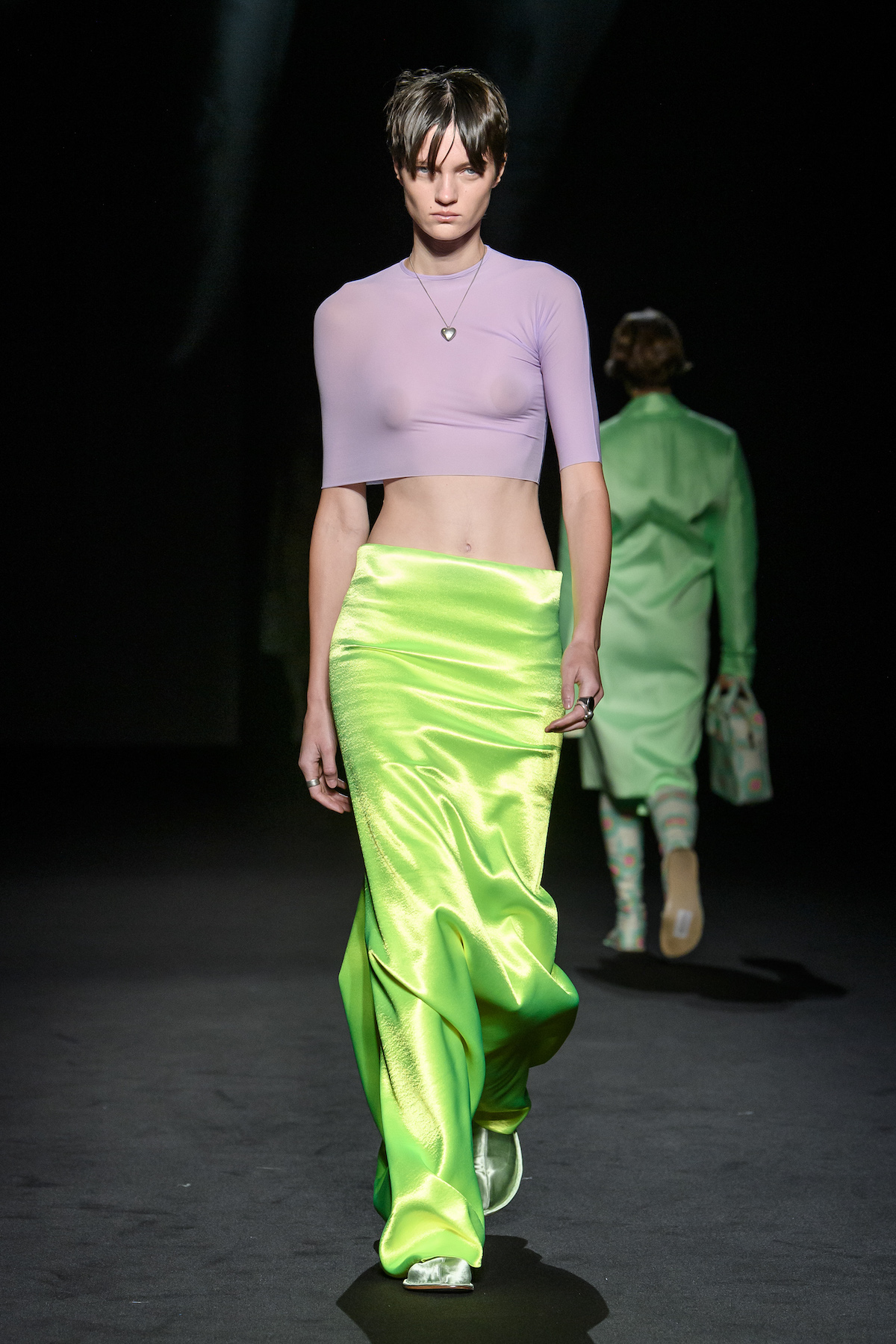
‘Bouba/Kiki’ was the title given to Sportmax’s latest collection, its name in reference to a series of psychological experiments begun by Wolfgang Köhler in 1929 – and continued by various researchers since – in which participants were asked to attribute words and sound to certain shapes (in one, most people selected the word ‘bouba’ for the curvier, rounder shapes, and ‘kiki’ for the sharper, spiker ones). It made for an eccentric, experimental offering – ‘an affirmation of otherness, resistant to conformism, whilst on a continuous quest for the extreme,’ as Sportmax described – comprising juxtapositions of fabric and print with softly sculptural silhouettes. A riff on nostalgia came in bustled skirts and nipped-waisted blazers, modernised in contemporary fabrications – like one flared skirt in high shine black, a vivid flash of lime green appearing from its underside as the model walked.
Missoni
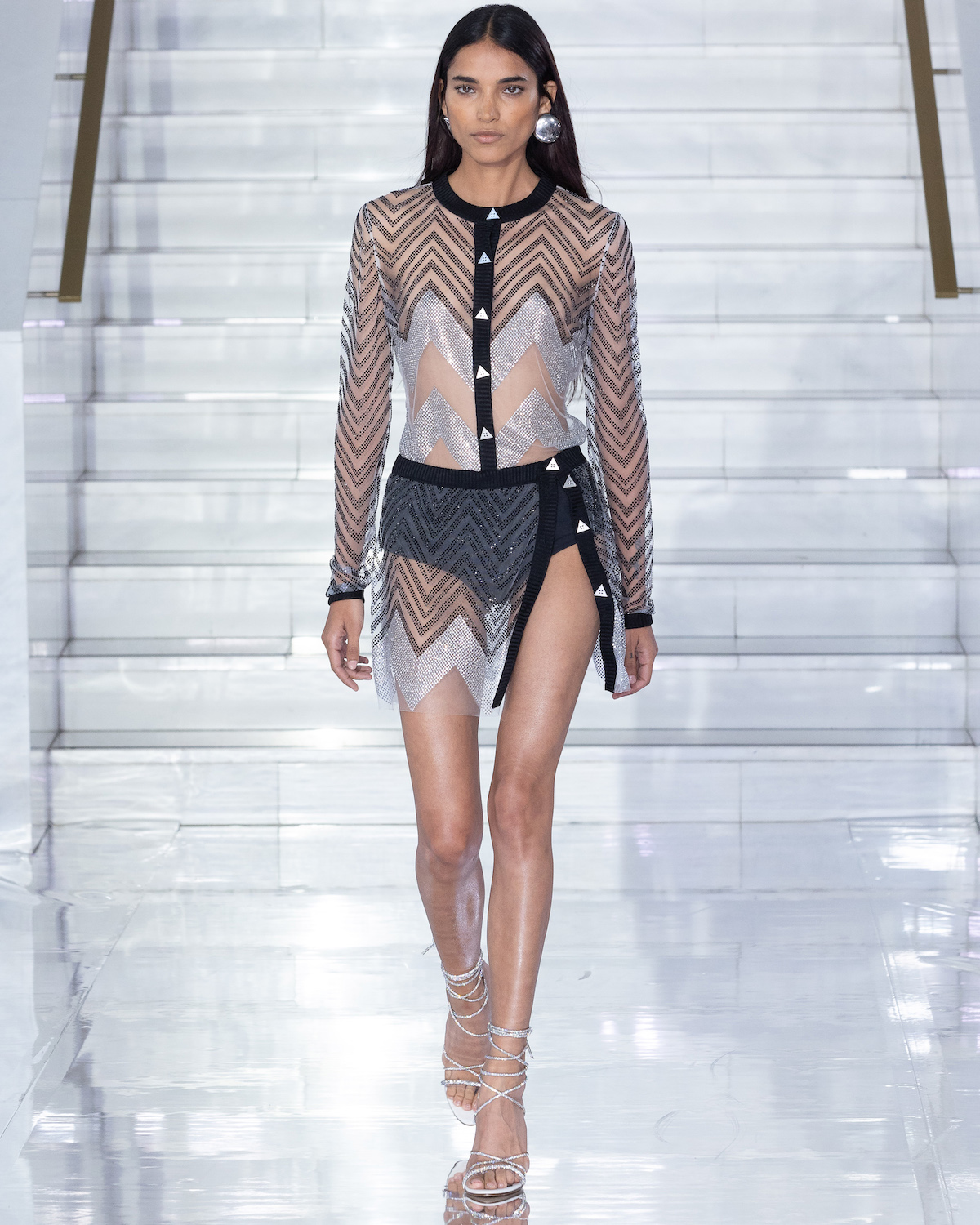
‘The Missoni language, spoken in the present tense, by a new author,’ said the Italian house of its latest chapter, helmed by new creative Filippo Grazioli, who has previously held stints at Givenchy, Hermès, Maison Margiela and Burberry (he showed a men’s collection for Missoni in a series of appointments in June; this marked his first runway show). The designer noted a desire for lightness – a freshening up of the house codes and motifs – in a ‘sensual and joyful’ collection, where 90s-inspired abbreviated silhouettes and slick, body-conscious shapes met zig-zagging prints and vivid tones (a palette of yellow, magenta, cyan, and black and white, was inspired by CMYK, the graphic design colour model used for printing). ‘Fashion as an injection of cheerfulness and lightness of spirit; colour and light that entice a smile,’ Missoni described of Grazioli’s invigorating first outing, which looks set to instil the historic Italian house with new energy.
Tod’s
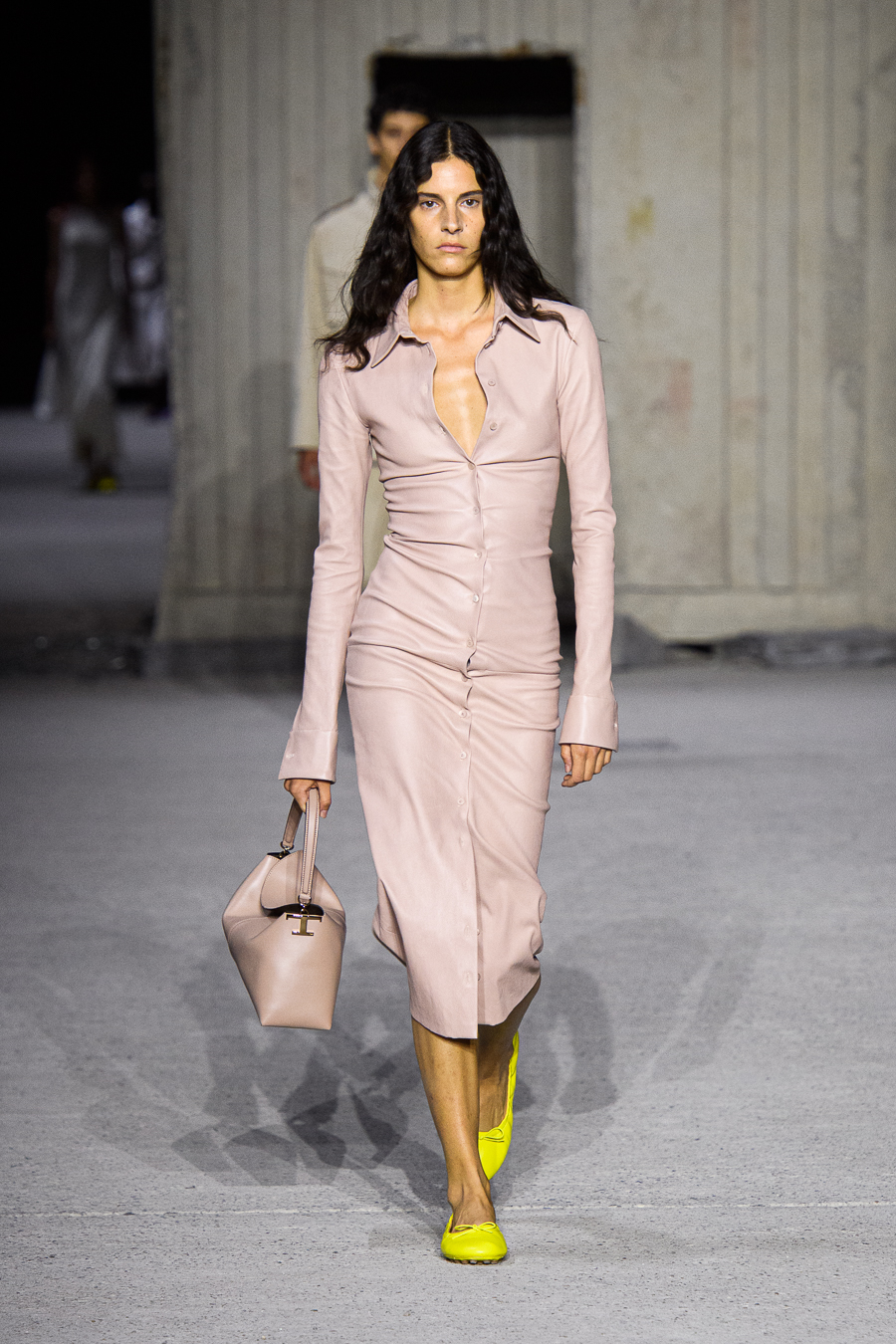
The vast Pirelli Hangarbicocca – a former industrial plant for the tire manufacturer, now a contemporary art institution – provided a dramatic backdrop for Tod’s latest collection, seeing models weave their way around Anselm Kiefer’s monumental concrete towers which populate the foundation’s main hall (the work itself is titled ‘The Seven Heavenly Palaces’). Despite the dramatic surroundings, the collection itself had a more intimate feel, riffs on what Walter Chiapponi describes as ‘essential pieces and iconic garments’ – archetypal womenswear filtered through the creative director’s minimal, 90s-inflected lens. Focus on fabrication remained central – particularly leather ‘which becomes almost like fabric, soft to the hand and sensual on the body’ – while an array of accessories, notably a ballet shoe melded with Tod’s signature Gomminno moccasin sole, completed the elegant proposition for next season’s wardrobe.
Thursday 22 September
Emporio Armani
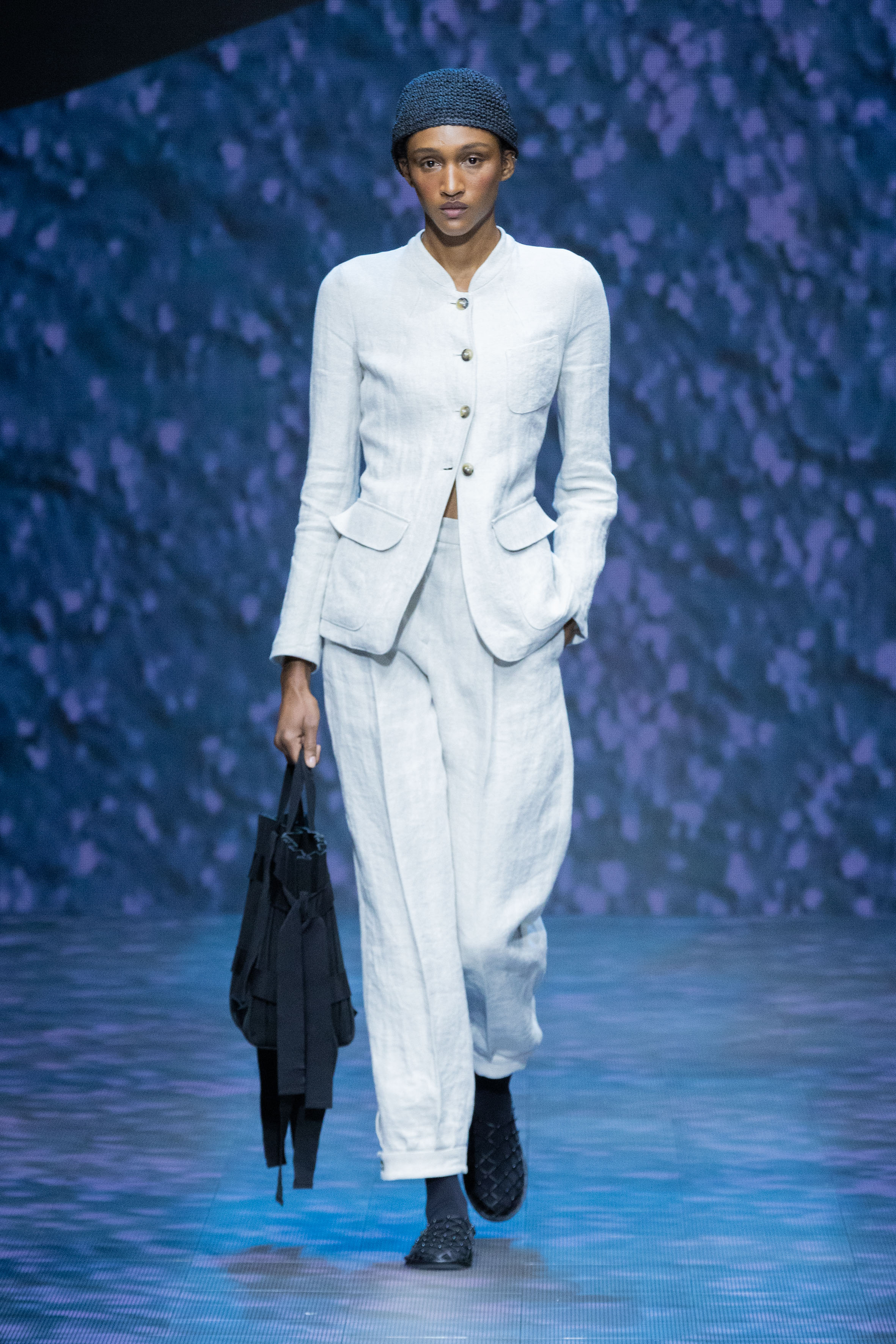
A feeling of eclecticism has permeated Giorgio Armani’s recent collections at both his eponymous line and Emporio Armani, the latter showing its S/S 2023 collection on Friday afternoon at the house’s Teatro Armani show space. Titled ‘In Transit’, it melded often disparate inspirations gleaned from travels around the world – from silhouette to surface embellishment – nodding towards their origins, but always refracted through the designer’s own effortless lens. As such, there were various riffs on the relaxed blazer (unstructured, buttoned to the collar double-breasted), elegant outerwear (‘the soft precision of jackets and peacoats… liquid languor’), and elements inspired by travel. It lent the collection a carefree, liberated air: ‘one might travel the world’s streets, or the imagination, within a room, as long as the mind is open and the spirit free.’
Prada

A vast rendering of a house in black paper – an inversion of the crisp white set which backdropped Prada’s menswear collection in June – set an unsettling tone for Miuccia Prada and Raf Simons’ latest collection, which they titled ‘Touch of Crude’. The mise-en-scène was a collaboration with filmmaker Nicolas Winding Refn; through cut-out windows and tears in the paper played a series of short films he had created for the occasion, each a play on the domestic (a woman removing her shoes, the underside of a mattress, the textures of carpet and sofas) – as if glimpsing something which shouldn’t be seen. ‘Although the collaboration is around the show, rather than the collection, we have been inspired by the collaboration, by his perspective on Prada,’ said Simons in a prepared statement. ‘There’s a mirror of cinema in the collection, of witnessing fragments of a larger whole. Different bodies of work, within a single body of work – shifting between disparate form languages.’
Indeed, there was a cinematic feel to the collection itself – afterwards, several attendees mentioned the potential inspiration of 1968 psychodrama Rosemary’s Baby in both the clothing and ominous mood – which the house described as ‘a sequence of realities, reflections, refractions, observations’. The designers noted a feeling of paradox in the collection: ‘raw and the sensual, between delicacy and roughness, an emulsification of contrasts’, figuring in the clothing in archetypically ladylike garments – a silk slip dress, a knitted two set, a nightgown – purposely torn across the hem, or embedded with creases, ‘like memories of beauty embedded in cloth’ (such moments also reflect the feeling of ‘crudeness’ referenced in the collection’s title). Other garments opposed a reductionist approach to design and silhouette with moments of decoration; notably, a series of otherwise minimal knitwear decorated with fabric flowers. ‘Reality translates to humanity. It is reflected through a sense of the hand, a touch of the crude, a rawness that evokes a fragility,’ read the collection notes.
Adds Miuccia Prada: ‘The clothes are about simplicity, with no unnecessary complication. Politically, theoretically, aesthetically, we are drawn to these notions again and again. The idea of directness. Yet with this collection it was combined with the idea of decoration, beauty, how to decorate and embellish, but remain simple.’
Max Mara
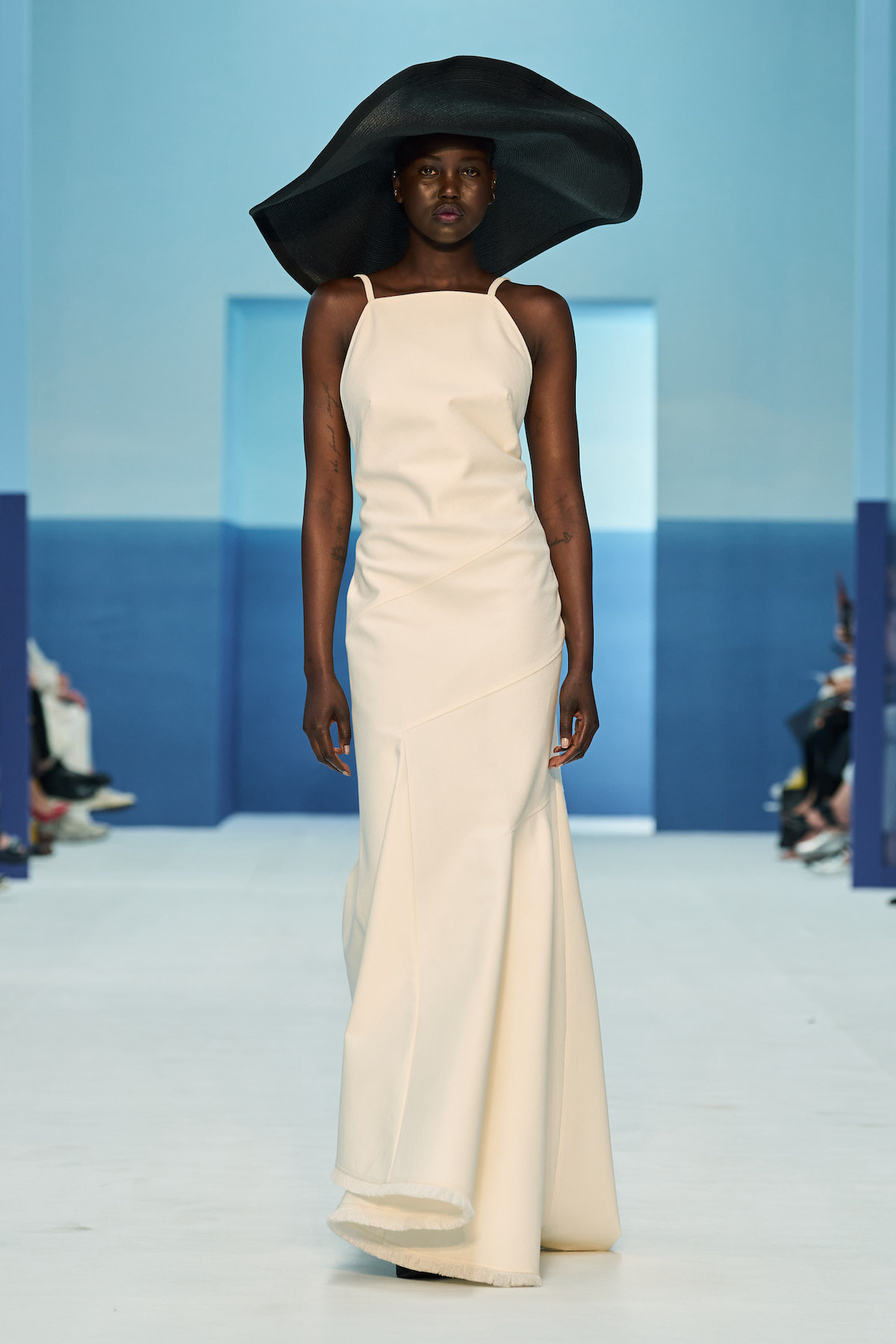
In previous seasons, Ian Griffiths has noted what he calls ‘Max Mara pantheon of strong women’, figures from history, spanning intellectual and creative realms, who inspire his feminist approach to design. For the spring/summer season, he headed on a journey to the south in France – and back in time – to the early 20th century, when from April to September ‘bohemians flocked to the riviera’. Among them, revolutionary women of the day Dora Maar, Dorothy Parker, Josephine Baker, Isadora Duncan and, notably for Griffiths, Renée Perle, who of the then-newfound Riviera style he says ‘nobody wore it better’ (wide-brimmed sun hats, languid sailor trousers, backless tank tops and the like). Here, an imagined meeting between Perle and modernist architect Eileen Gray – perhaps best known for her E-1027 villa in Roquebrune-Cap-Martin and ‘uniquely feminine take on modernism’ – saw Riviera-style hallmarks filtered through a clean, minimal lens for a contemporary take on getaway wear. ‘Two women with a shared vision of modernity stepping out onto the E-1037 terrace,’ read the collection notes. ‘Blinking in the morning's light, we see them raise their smiling faces to meet the glittering blue horizon.’
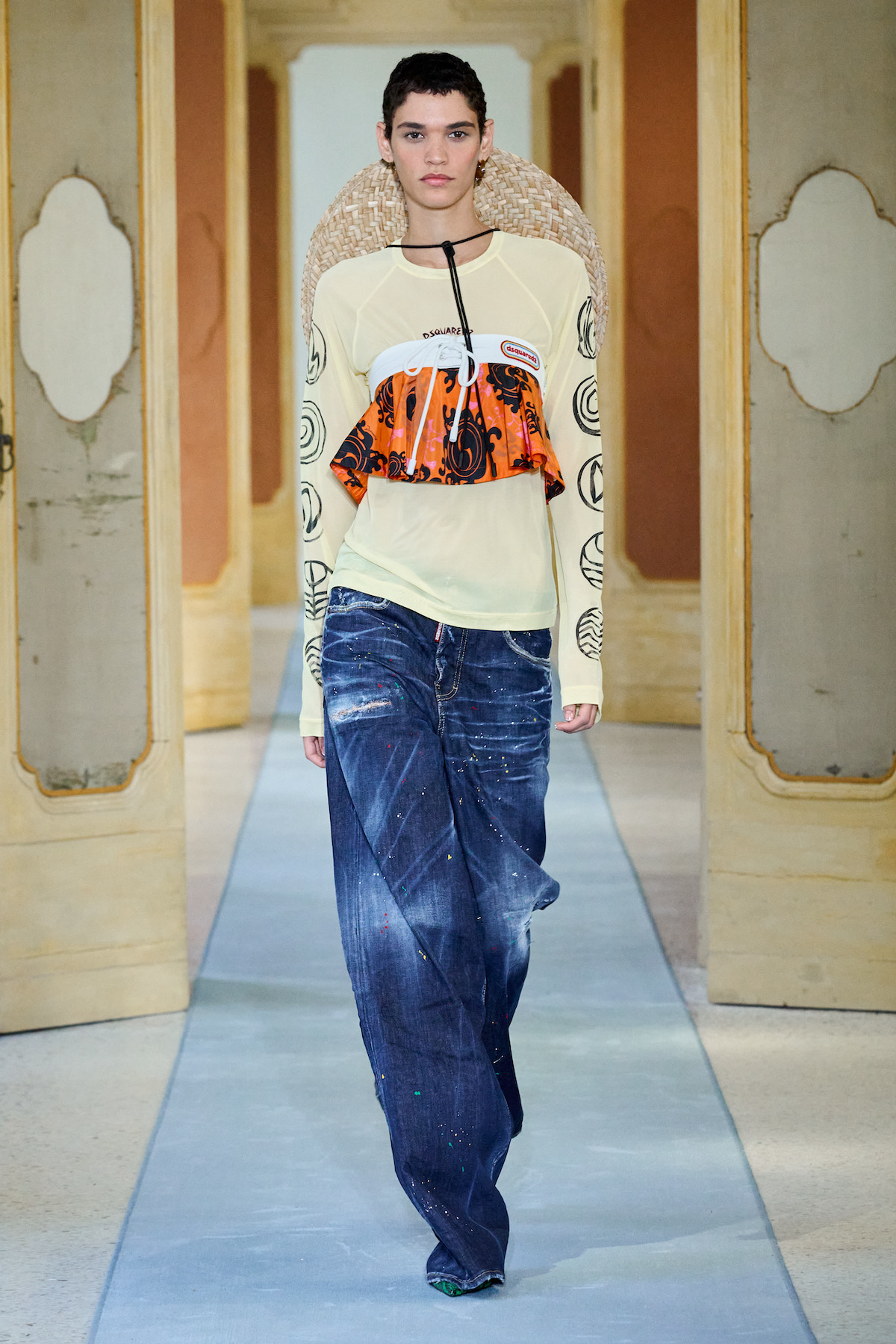
DSquared2
A continuation of their menswear show in June, Dean and Dan Caten looked once again to the archetype of the surfer, a figure of freedom and escape which has proved a longtime inspiration for the Canadian designers (the pair noted backstage that they surf themselves). ‘Where the waves roll in, the sunlight shimmers on a wardrobe that’s found its chill beachside,’ read the accompanying notes, setting the scene for a carefree collection where an unabashed collage of colour and print met a feeling of lightness in transparent and semi-sheer layers. A smattering of feminine embellishments – sequins, ruffles, cut-outs reminiscent of broderie anglaise – completed the collection, which in its airy eclecticism felt like a fresh shift in direction for the Milanese stalwarts.
Wednesday 21 September
Fendi
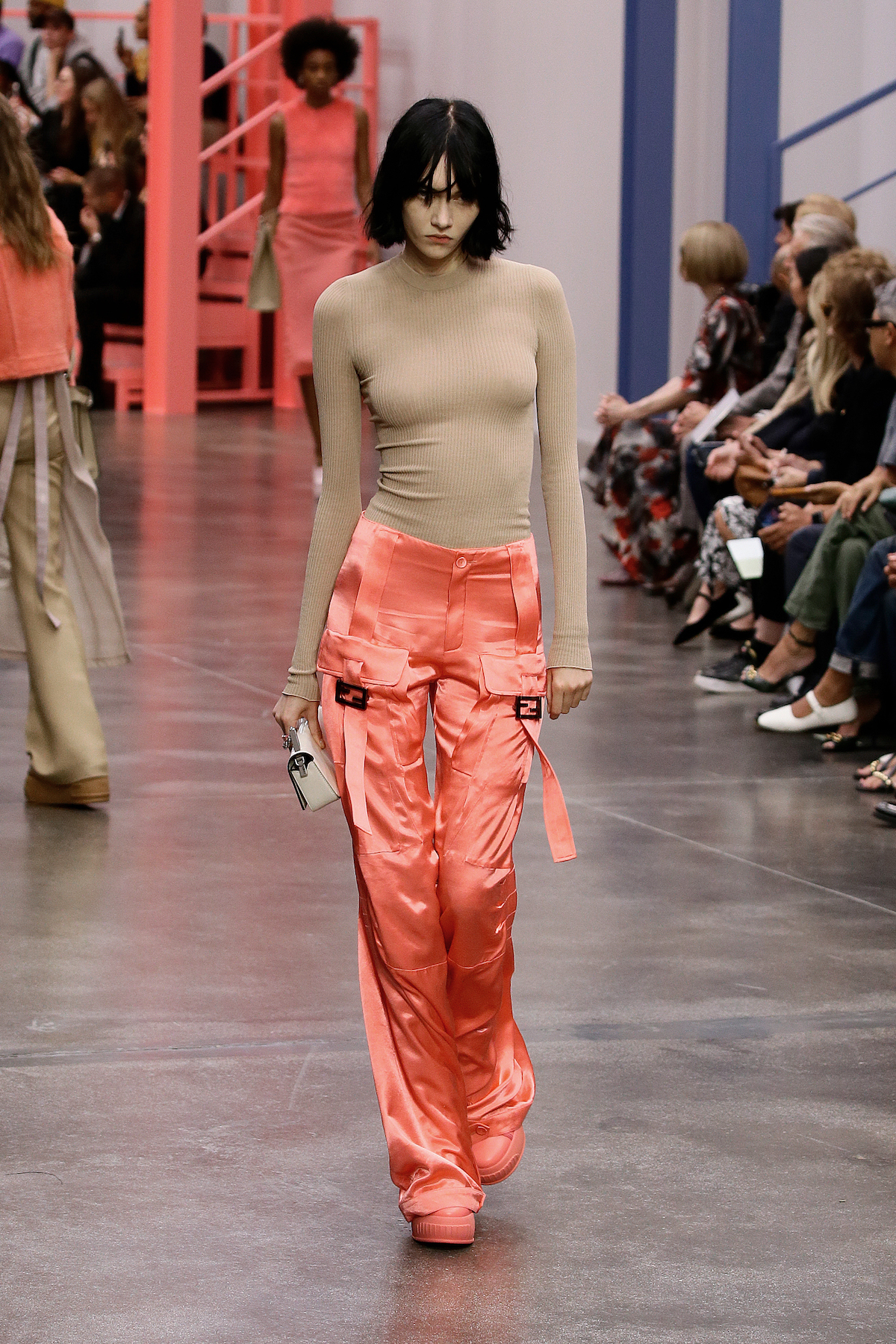
‘It’s about continuity,’ Kim Jones said of his S/S 2023 collection, which looked back to the turn of the millennium and forebear Karl Lagerfeld’s designs of the era, linking a thread between past and present. It’s a time period which has become familiar territory for the designer of late; earlier this month in New York, he celebrated 25 years of the Fendi ‘Baguette’ handbag – arguably the most symbolic It-bag of the late 1990s and early 2000s – with a colourful, star-studded runway show (such is the relative speed of Kim Jones’ work, which spans over ten collections a year, some of these looks were already being worn by the gathered audience). ‘I am interested in things that Karl has done, and seeing how we can develop them – both visually and technically’.
Set to a euphoric rave-inspired soundtrack, these current Y2K fixations emerged in a collection that the designer described as ‘colliding minimalist ease and pop-infused eclectism’. Of the former, a series of elegant silk cargo pants, tabard-style shirts, simple ribbed knits and racer-back vests, of the latter, an enlivening palette, from bubblegum pink to vivid shades of green, lending the collection a light, playful air (as did the accessories – one necklace was adorned with a tiny miniature handbag; another handbag was made to resemble a gift wrapped in red ribbon). Such oppositions are now a hallmark of Jones’ tenure, the designer noting that at Fendi he is ‘constantly thinking about practicality and luxury’, of exploring ‘the notion of functional utility alongside femininity – because the Fendi women are strong women, with full, busy lives’.
Del Core

Despite being relatively young by Milanese standards, Del Core – the eponymous 2020-founded label of Daniel Del Core, previously an in-house designer at Gucci – has nonetheless found a groove creating dressed-up garments defined by a steadfast focus on craft (gowns are often festooned with sequins and surface embellishment, while his ‘Made in Italy’ credentials are at the centre of the label). Held in an industrial warehouse on Milan’s Navigli canal, the starkness of the surroundings threw the collection into relief: pinched-waist tailoring, diaphanous sheer gowns, a November Rain-style asymmetric skirt, which descended into bold folds of yellow fabric. Del Core said he was inspired by the idea of ‘liquidity’ – a ‘constantly changing state’, where ‘shapes flow effortlessly onto the body’ and ‘colours mutate’. Case in point: the collection’s dramatic final look, a vivid gown with a pannier waist, decorated with thousands of sequins, which shimmered and shifted in the runway’s light.
No 21
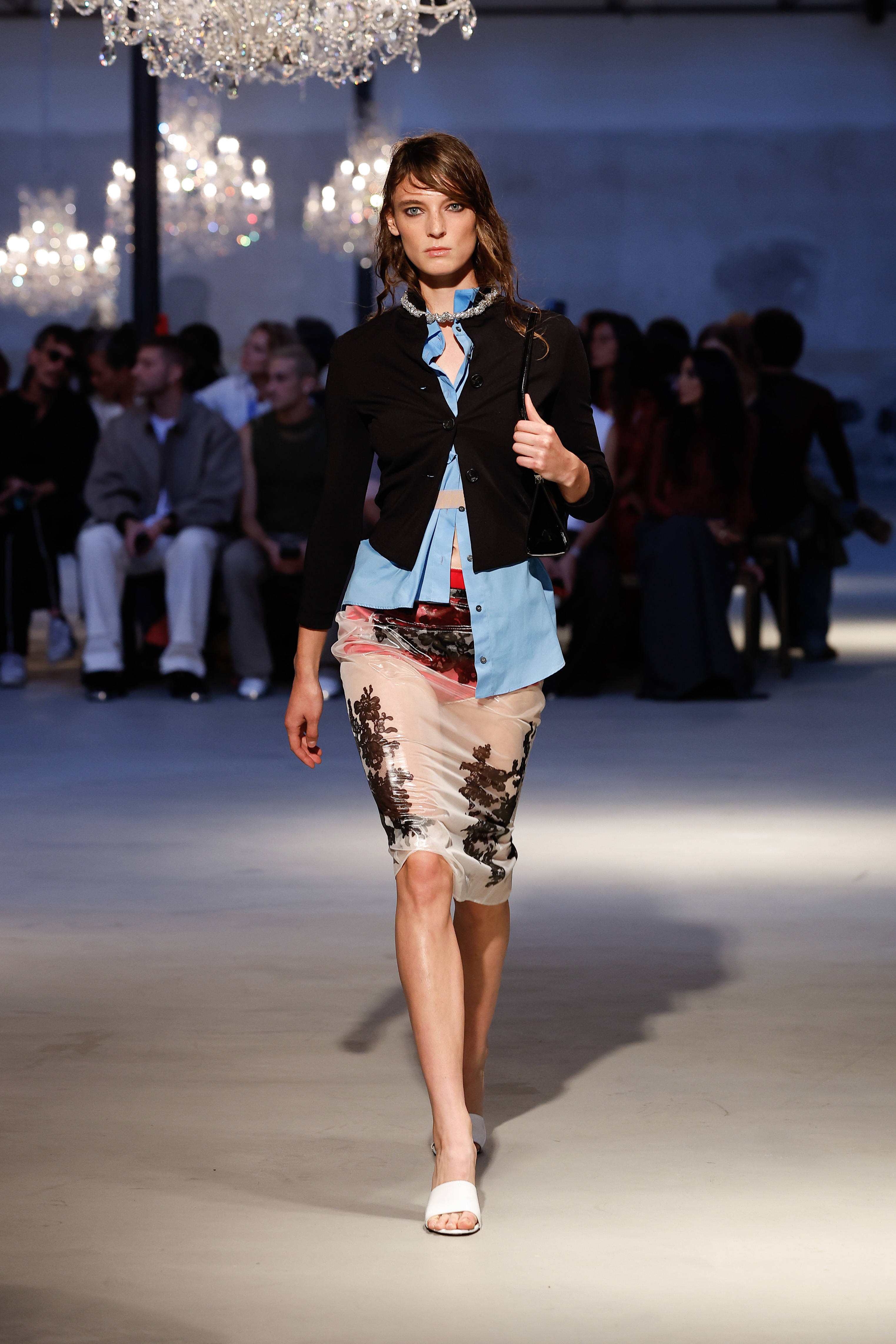
The agonies and ecstasies of love provided the inspiration behind the latest collection from Alessandro Dell’Acqua at No 21, who hosted this season’s show against the background of a previously industrial warehouse, hung for the occasion with glittering chandeliers. Titling the collection ‘The Lovers’, Dell’Acqua noted he wanted to encapsulate the swinging emotions one feels when in love, here refracted through a feeling of nostalgic glamour – two sets, dresses overlaid with lace, evening gloves, crystal jewellery – albeit dishevelled, with garments slipping off the shoulder or purposely scrunched (models’ bodies and faces were also spritzed with droplets of water to evoke rain, or tears). It was a typically commanding, and indeed cinematic, vision from veteran designer Dell’Acqua, who remains one of the highlights of the Milanese schedule.
INFORMATION
Jack Moss is the Fashion & Beauty Features Director at Wallpaper*, having joined the team in 2022 as Fashion Features Editor. Previously the digital features editor at AnOther and digital editor at 10 Magazine, he has also contributed to numerous international publications and featured in ‘Dazed: 32 Years Confused: The Covers’, published by Rizzoli. He is particularly interested in the moments when fashion intersects with other creative disciplines – notably art and design – as well as championing a new generation of international talent and reporting from international fashion weeks. Across his career, he has interviewed the fashion industry’s leading figures, including Rick Owens, Pieter Mulier, Jonathan Anderson, Grace Wales Bonner, Christian Lacroix, Kate Moss and Manolo Blahnik.
-
 The Testament of Ann Lee brings the Shaker aesthetic to the big screen
The Testament of Ann Lee brings the Shaker aesthetic to the big screenDirected by Mona Fastvold and featuring Amanda Seyfried, The Testament of Ann Lee is a visual deep dive into Shaker culture
-
 Dive into Buccellati's rich artistic heritage in Shanghai
Dive into Buccellati's rich artistic heritage in Shanghai'The Prince of Goldsmiths: Buccellati Rediscovering the Classics' exhibition takes visitors on an immersive journey through a fascinating history
-
 Love jewellery? Now you can book a holiday to source rare gemstones
Love jewellery? Now you can book a holiday to source rare gemstonesHardy & Diamond, Gemstone Journeys debuts in Sri Lanka in April 2026, granting travellers access to the island’s artisanal gemstone mines, as well as the opportunity to source their perfect stone
-
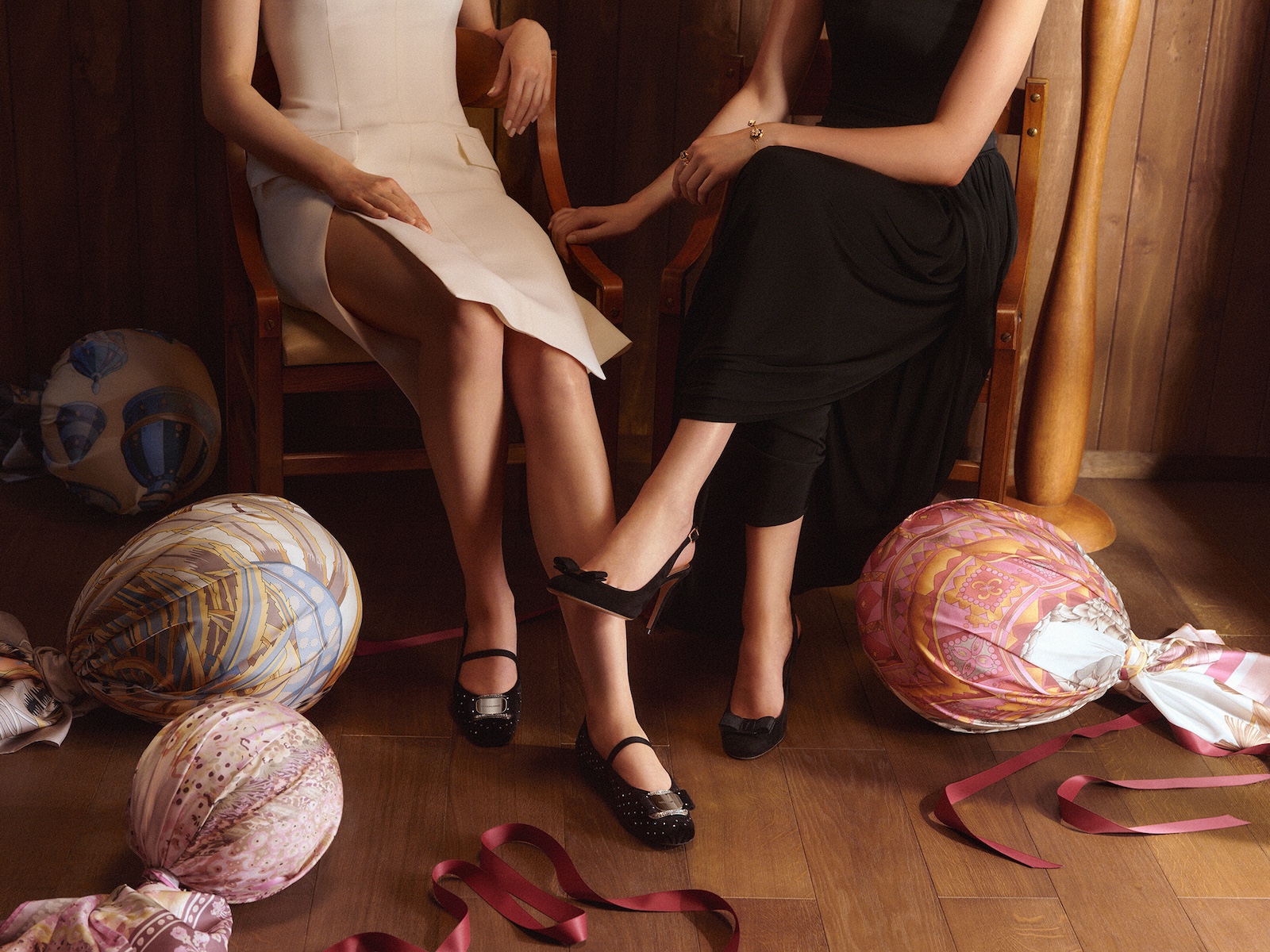 Ferragamo gifts come imbued with glamour and nostalgia this season
Ferragamo gifts come imbued with glamour and nostalgia this seasonIn a series of short films and images, the Italian fashion house celebrates gift-giving and offers an array of wishlist-worthy examples, from bags to shoes and scarves
-
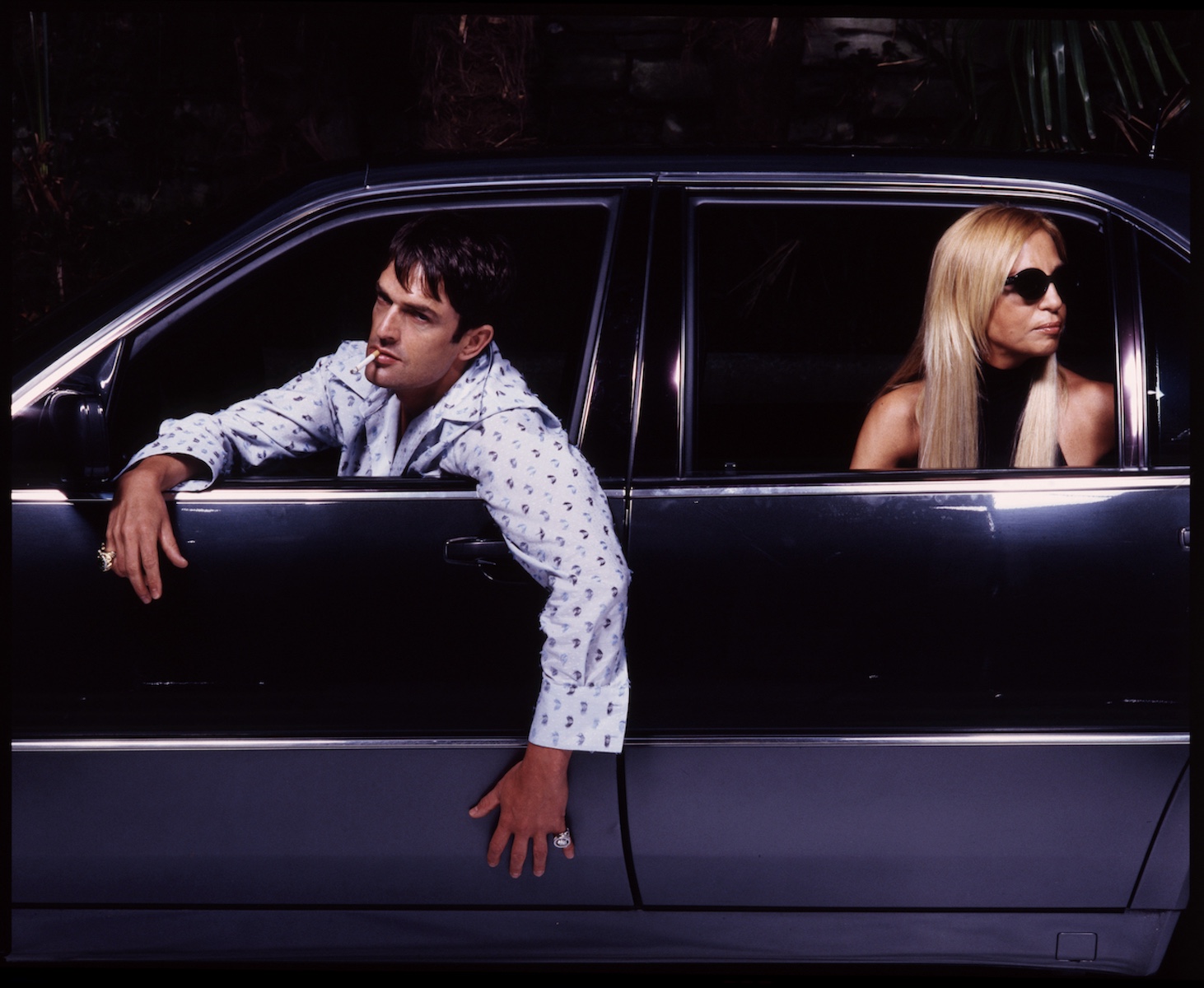 The story behind Gian Paolo Barbieri’s cinematic fashion photography, which helped define the 1990s
The story behind Gian Paolo Barbieri’s cinematic fashion photography, which helped define the 1990sA new Milan exhibition explores the legacy of Gian Paolo Barbieri, a photographer who would shape a vision of Italian style alongside collaborators Versace, Armani and Valentino
-
 The key takeaways from the S/S 2026 shows: freedom, colour and romance define fashion’s new chapter
The key takeaways from the S/S 2026 shows: freedom, colour and romance define fashion’s new chapterWe unpack the trends and takeaways from the S/S 2026 season, which saw fashion embrace a fresh start with free-spirited collections and a bold exploration of colour and form
-
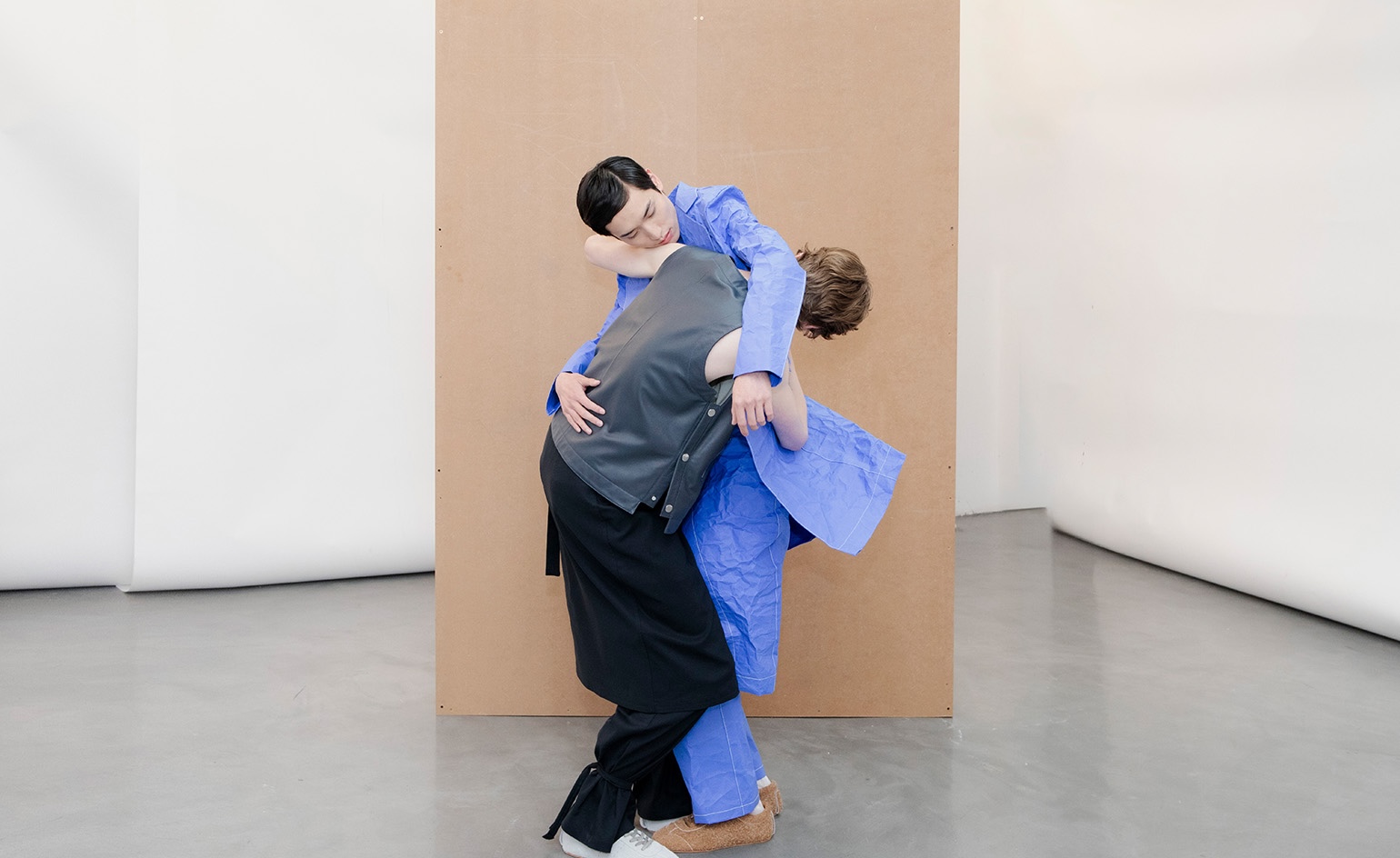 The independent designers you might have missed from fashion month S/S 2026
The independent designers you might have missed from fashion month S/S 2026Amid a tidal wave of big-house debuts, we take you through the independent displays that may have slipped through the cracks – from beautiful imagery to bookshop takeovers, museum displays and moves across the pond
-
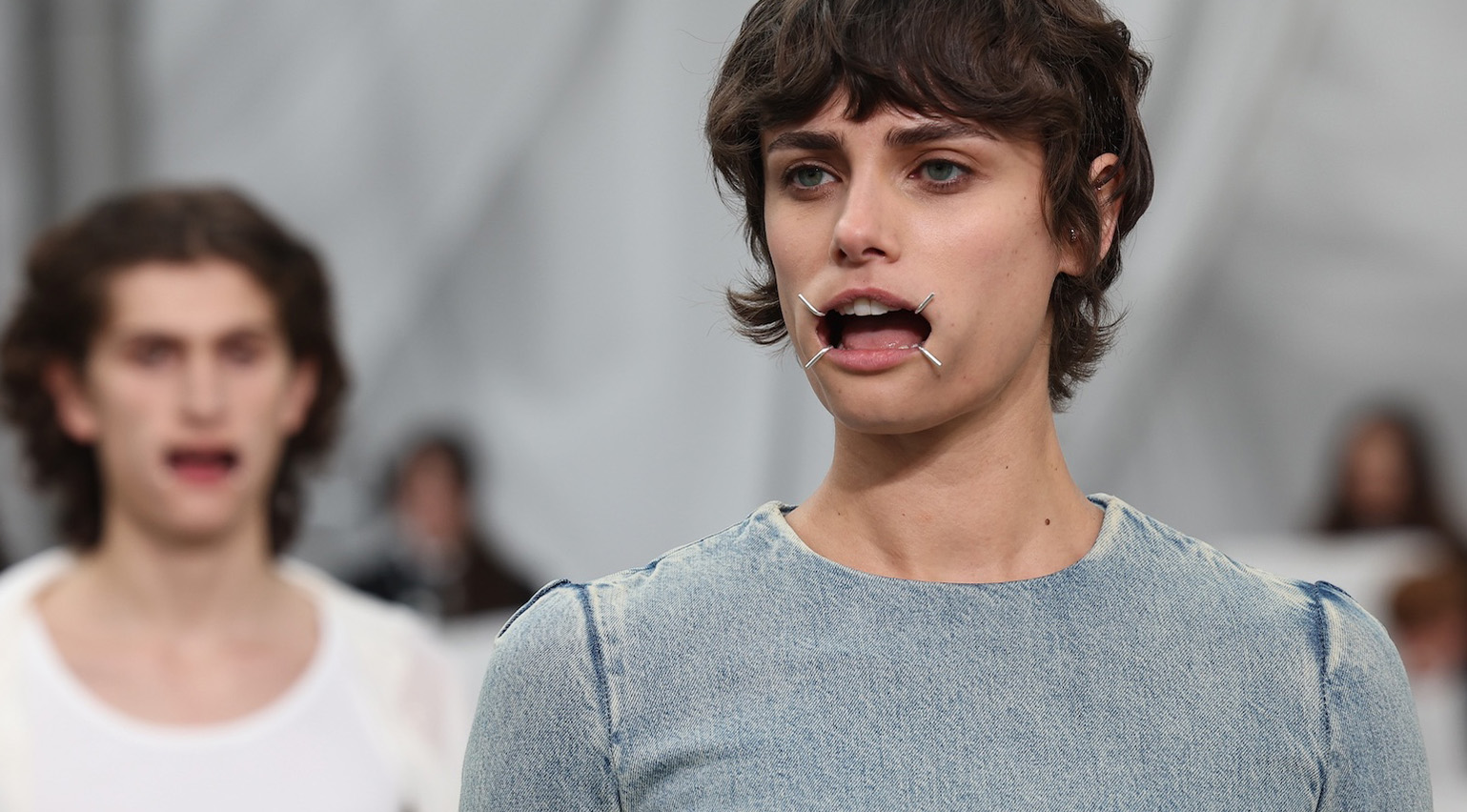 From wearable skincare to scented runways, unpacking the unconventional beauty moments of fashion month S/S 2026
From wearable skincare to scented runways, unpacking the unconventional beauty moments of fashion month S/S 2026The S/S 2026 season featured everything from probiotic-lined athleisure to fragranced runways – and those Maison Margiela mouthguards
-
 In Milan, the fashion world gathers to say goodbye to Giorgio Armani at his final show
In Milan, the fashion world gathers to say goodbye to Giorgio Armani at his final showOriginally planned to mark the 50th anniversary of Giorgio Armani’s eponymous house, Sunday evening’s runway show at Milan’s Pinacoteca di Brera would prove to be the last from the designer, who passed away earlier this month aged 91
-
 Dario Vitale makes sexually-charged debut for Versace, inspired by the ‘bold attitude’ of Gianni Versace
Dario Vitale makes sexually-charged debut for Versace, inspired by the ‘bold attitude’ of Gianni VersaceSucceeding Donatella Versace, the ex-Miu Miu design director is the first to helm the brand outside of the Versace family. His debut last night in Milan was staged within the opulent rooms of Pinacoteca Ambrosiana
-
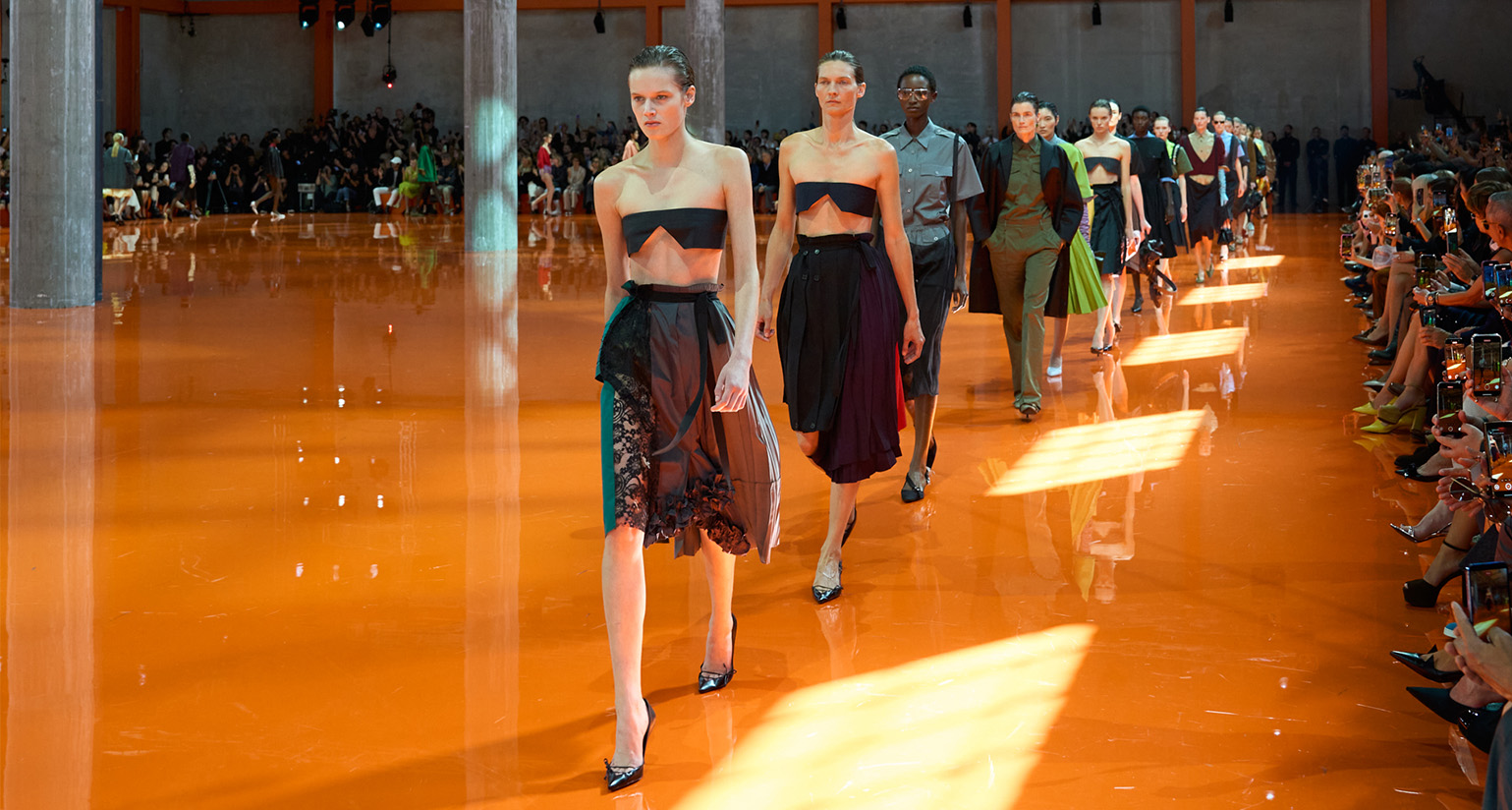 The standout shows of Milan Fashion Week S/S 2026
The standout shows of Milan Fashion Week S/S 2026This season in Milan, the city is enjoying a wave of creative director debuts, from Demna at Gucci to Louise Trotter at Bottega Veneta. Here are the Wallpaper* highlights so far